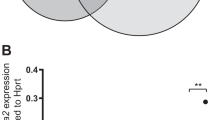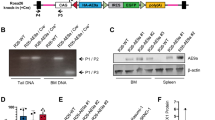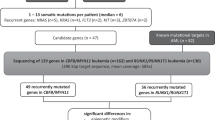Abstract
Chromosomal translocations are important genetic perturbations frequently associated with hematologic malignancies; characterization of these events has been a rich source of insights into the mechanisms that lead to malignant transformation. The t(10;11)(p13;q14–21) results in a recently identified rare but recurring chromosomal translocation seen in patients with ALL as well as AML, and results in the production of a CALM–AF10 fusion gene. Although the details by which the CALM–AF10 fusion protein exerts its leukemogenic effect remain unclear, emerging data suggests that the CALM–AF10 fusion impairs differentiation of hematopoietic cells, at least in part via an upregulation of HOXA cluster genes. This review discusses the normal structure and function of CALM and AF10, describes the spectrum of clinical findings seen in patients with CALM–AF10 fusions, summarizes recently published CALM–AF10 mouse models and highlights the role of HOXA cluster gene activation in CALM–AF10 leukemia.
This is a preview of subscription content, access via your institution
Access options
Subscribe to this journal
Receive 12 print issues and online access
$259.00 per year
only $21.58 per issue
Buy this article
- Purchase on Springer Link
- Instant access to full article PDF
Prices may be subject to local taxes which are calculated during checkout

Similar content being viewed by others
References
Rabbitts TH . Translocations, master genes, and differences between the origins of acute and chronic leukemias. Cell 1991; 67: 641–644.
Rabbitts TH . Chromosomal translocations in human cancer. Nature 1994; 372: 143–149.
Cline MJ . The molecular basis of leukemia. N Engl J Med 1994; 330: 328–336.
Thandla S, Aplan PD . Molecular biology of acute lymphocytic leukemia. Semin Oncol 1997; 24: 45–56.
Rowley JD . The role of chromosome translocations in leukemogenesis. Semin Hematol 1999; 36 (4 Suppl 7): 59–72.
Rowley JD . Chromosome translocations: dangerous liaisons revisited. Nat Rev Cancer 2001; 1: 245–250.
Rubnitz JE, Behm FG, Downing JR . 11q23 rearrangements in acute leukemia. Leukemia 1996; 10: 74–82.
Sundstrom C, Nilsson K . Establishment and characterization of a human histiocytic lymphoma cell line (U-937). Int J Cancer 1976; 17: 565–577.
Harris P, Ralph P . Human leukemic models of myelomonocytic development: a review of the HL-60 and U937 cell lines. J Leukoc Biol 1985; 37: 407–422.
Kobayashi H, Thirman MJ, Rowley JD . U937 cell line has a t(10;11)(p13–14;q14–21) rather than a deletion of 11q. Genes Chromosomes Cancer 1995; 13: 217–218.
Shipley J, Williams S, O’Byrne A, Kearney L, Jones T, Young B et al. Characterization of a t(10;11)(p13–14;q14–21) in the monoblastic cell line U937. Genes Chromosomes Cancer 1995; 13: 138–142.
Dreyling MH, Martinez-Climent JA, Zheng M, Mao J, Rowley JD, Bohlander SK . The t(10;11)(p13;q14) in the U937 cell line results in the fusion of the AF10 gene and CALM, encoding a new member of the AP-3 clathrin assembly protein family. Proc Natl Acad Sci USA 1996; 93: 4804–4809.
Meyerholz A, Hinrichsen L, Groos S, Esk PC, Brandes G, Ungewickell EJ . Effect of clathrin assembly lymphoid myeloid leukemia protein depletion on clathrin coat formation. Traffic 2005; 6: 1225–1234.
Tebar F, Bohlander SK, Sorkin A . Clathrin assembly lymphoid myeloid leukemia (CALM) protein: localization in endocytic-coated pits, interactions with clathrin, and the impact of overexpression on clathrin-mediated traffic. Mol Biol Cell 1999; 10: 2687–2702.
Klebig ML, Wall MD, Potter MD, Rowe EL, Carpenter DA, Rinchik EM . Mutations in the clathrin-assembly gene Picalm are responsible for the hematopoietic and iron metabolism abnormalities in fit1 mice. Proc Natl Acad Sci USA 2003; 100: 8360–8365.
Ahle S, Ungewickell E . Purification and properties of a new clathrin assembly protein. EMBO J 1986; 5: 3143–3149.
Takei K, Mundigl O, Daniell L, De Camilli P . The synaptic vesicle cycle: a single vesicle budding step involving clathrin and dynamin. J Cell Biol 1996; 133: 1237–1250.
Mukherjee S, Ghosh RN, Maxfield FR . Endocytosis. Physiol Rev 1997; 77: 759–803.
Schmid SL . Clathrin-coated vesicle formation and protein sorting: an integrated process. Annu Rev Biochem 1997; 66: 511–548.
Robinson MS, Bonifacino JS . Adaptor-related proteins. Curr Opin Cell Biol 2001; 13: 444–453.
Dell’Angelica EC, Klumperman J, Stoorvogel W, Bonifacino JS . Association of the AP-3 adaptor complex with clathrin. Science 1998; 280: 431–434.
Wendland B, Emr SD . Pan1p, yeast eps15, functions as a multivalent adaptor that coordinates protein-protein interactions essential for endocytosis. J Cell Biol 1998; 141: 71–84.
Zhang B, Koh YH, Beckstead RB, Budnik V, Ganetzky B, Bellen HJ . Synaptic vesicle size and number are regulated by a clathrin adaptor protein required for endocytosis. Neuron 1998; 21: 1465–1475.
Archangelo LF, Glasner J, Krause A, Bohlander SK . The novel CALM interactor CATS influences the subcellular localization of the leukemogenic fusion protein CALM/AF10. Oncogene 2006; 25: 4099–4109.
Wechsler DS, Engstrom LD, Alexander BM, Motto DG, Roulston D . A novel chromosomal inversion at 11q23 in infant acute myeloid leukemia fuses MLL to CALM, a gene that encodes a clathrin assembly protein. Genes Chromosomes Cancer 2003; 36: 26–36.
Chaplin T, Bernard O, Beverloo HB, Saha V, Hagemeijer A, Berger R et al. The t(10;11) translocation in acute myeloid leukemia (M5) consistently fuses the leucine zipper motif of AF10 onto the HRX gene. Blood 1995; 86: 2073–2076.
Chaplin T, Ayton P, Bernard OA, Saha V, Della Valle V, Hillion J et al. A novel class of zinc finger/leucine zipper genes identified from the molecular cloning of the t(10;11) translocation in acute leukemia. Blood 1995; 85: 1435–1441.
Linder B, Jones LK, Chaplin T, Mohd-Sarip A, Heinlein UA, Young BD et al. Expression pattern and cellular distribution of the murine homologue of AF10. Biochim Biophys Acta 1998; 1443: 285–296.
Linder B, Newman R, Jones LK, Debernardi S, Young BD, Freemont P et al. Biochemical analyses of the AF10 protein: the extended LAP/PHD-finger mediates oligomerisation. J Mol Biol 2000; 299: 369–378.
Aasland R, Gibson TJ, Stewart AF . The PHD finger: implications for chromatin-mediated transcriptional regulation. Trends Biochem Sci 1995; 20: 56–59.
Aravind L, Landsman D . AT-hook motifs identified in a wide variety of DNA-binding proteins. Nucleic Acids Res 1998; 26: 4413–4421.
Debernardi S, Bassini A, Jones LK, Chaplin T, Linder B, de Bruijn DR et al. The MLL fusion partner AF10 binds GAS41, a protein that interacts with the human SWI/SNF complex. Blood 2002; 99: 275–281.
Morerio C, Rapella A, Tassano E, Rosanda C, Panarello C . MLL-MLLT10 fusion gene in pediatric acute megakaryoblastic leukemia. Leuk Res 2005; 29: 1223–1226.
Borkhardt A, Haas OA, Strobl W, Repp R, Mann G, Gadner H et al. A novel type of MLL/AF10 fusion transcript in a child with acute megakaryocytic leukemia (AML-M7). Leukemia 1995; 9: 1796–1797.
DiMartino JF, Ayton PM, Chen EH, Naftzger CC, Young BD, Cleary ML . The AF10 leucine zipper is required for leukemic transformation of myeloid progenitors by MLL-AF10. Blood 2002; 99: 3780–3785.
Okada Y, Feng Q, Lin Y, Jiang Q, Li Y, Coffield VM et al. hDOT1L links histone methylation to leukemogenesis. Cell 2005; 121: 167–178.
Groupe Francais de Cytogenetique Hematologique (GFCH). t(10;11)(p13–14;q14–21): a new recurrent translocation in T-cell acute lymphoblastic leukemias. Genes Chromosomes Cancer 1991; 3: 411–415.
Asnafi V, Radford-Weiss I, Dastugue N, Bayle C, Leboeuf D, Charrin C et al. CALM-AF10 is a common fusion transcript in T-ALL and is specific to the TCRgammadelta lineage. Blood 2003; 102: 1000–1006.
Abdelhaleem M, Beimnet K, Kirby-Allen M, Naqvi A, Hitzler J, Shago M . High incidence of CALM-AF10 fusion and the identification of a novel fusion transcript in acute megakaryoblastic leukemia in children without Down's syndrome. Leukemia 2007; 21: 352–353.
Kobayashi H, Hosoda F, Maseki N, Sakurai M, Imashuku S, Ohki M et al. Hematologic malignancies with the t(10;11) (p13;q21) have the same molecular event and a variety of morphologic or immunologic phenotypes. Genes Chromosomes Cancer 1997; 20: 253–259.
Salmon-Nguyen F, Busson M, Daniel M, Leblanc T, Bernard OA, Berger R . CALM-AF10 fusion gene in leukemias: simple and inversion-associated translocation (10;11). Cancer Genet Cytogenet 2000; 122: 137–140.
Abdou SM, Jadayel DM, Min T, Swansbury GJ, Dainton MG, Jafer O et al. Incidence of MLL rearrangement in acute myeloid leukemia, and a CALM-AF10 fusion in M4 type acute myeloblastic leukemia. Leuk Lymphoma 2002; 43: 89–95.
Jones LK, Chaplin T, Shankar A, Neat M, Patel N, Samuel DP et al. Identification and molecular characterisation of a CALM-AF10 fusion in acute megakaryoblastic leukaemia. Leukemia 2001; 15: 910–914.
Narita M, Shimizu K, Hayashi Y, Taki T, Taniwaki M, Hosoda F et al. Consistent detection of CALM-AF10 chimaeric transcripts in haematological malignancies with t(10;11)(p13;q14) and identification of novel transcripts. Br J Haematol 1999; 105: 928–937.
Bohlander SK, Muschinsky V, Schrader K, Siebert R, Schlegelberger B, Harder L et al. Molecular analysis of the CALM/AF10 fusion: identical rearrangements in acute myeloid leukemia, acute lymphoblastic leukemia and malignant lymphoma patients. Leukemia 2000; 14: 93–99.
Deshpande AJ, Cusan M, Rawat VP, Reuter H, Krause A, Pott C et al. Acute myeloid leukemia is propagated by a leukemic stem cell with lymphoid characteristics in a mouse model of CALM/AF10-positive leukemia. Cancer Cell 2006; 10: 363–374.
Kumon K, Kobayashi H, Maseki N, Sakashita A, Sakurai M, Tanizawa A et al. Mixed-lineage leukemia with t(10;11)(p13;q21): an analysis of AF10-CALM and CALM-AF10 fusion mRNAs and clinical features. Genes Chromosomes Cancer 1999; 25: 33–39.
Rabbitts TH . Chromosomal translocation master genes, mouse models and experimental therapeutics. Oncogene 2001; 20: 5763–5777.
Bernardi R, Grisendi S, Pandolfi PP . Modelling haematopoietic malignancies in the mouse and therapeutical implications. Oncogene 2002; 21: 3445–3458.
Forster A, Pannell R, Drynan L, Cano F, Chan N, Codrington R et al. Chromosomal translocation engineering to recapitulate primary events of human cancer. Cold Spring Harb Symp Quant Biol 2005; 70: 275–282.
Okada Y, Jiang Q, Lemieux M, Jeannotte L, Su L, Zhang Y . Leukaemic transformation by CALM-AF10 involves upregulation of Hoxa5 by hDOT1L. Nat Cell Biol 2006; 8: 1017–1024.
Caudell D, Zhang Z, Chung YJ, Aplan PD . Expression of a CALM-AF10 fusion gene leads to Hoxa cluster overexpression and acute leukemia in transgenic mice. Cancer Res 2007; 67: 8022–8031.
Balciunaite G, Ceredig R, Massa S, Rolink AG . A B220+ CD117+ CD19− hematopoietic progenitor with potent lymphoid and myeloid developmental potential. Eur J Immunol 2005; 35: 2019–2030.
Pearson JC, Lemons D, McGinnis W . Modulating Hox gene functions during animal body patterning. Nat Rev Genet 2005; 6: 893–904.
Garcia-Fernandez J . The genesis and evolution of homeobox gene clusters. Nat Rev Genet 2005; 6: 881–892.
van Oostveen J, Bijl J, Raaphorst F, Walboomers J, Meijer C . The role of homeobox genes in normal hematopoiesis and hematological malignancies. Leukemia 1999; 13: 1675–1690.
Abramovich C, Humphries RK . Hox regulation of normal and leukemic hematopoietic stem cells. Curr Opin Hematol 2005; 12: 210–216.
Grier DG, Thompson A, Kwasniewska A, McGonigle GJ, Halliday HL, Lappin TR . The pathophysiology of HOX genes and their role in cancer. J Pathol 2005; 205: 154–171.
Lam DH, Aplan PD . NUP98 gene fusions in hematologic malignancies. Leukemia 2001; 15: 1689–1695.
Soulier J, Clappier E, Cayuela JM, Regnault A, Garcia-Peydro M, Dombret H et al. HOXA genes are included in genetic and biologic networks defining human acute T-cell leukemia (T-ALL). Blood 2005; 106: 274–286.
Speleman F, Cauwelier B, Dastugue N, Cools J, Verhasselt B, Poppe B et al. A new recurrent inversion, inv(7)(p15q34), leads to transcriptional activation of HOXA10 and HOXA11 in a subset of T-cell acute lymphoblastic leukemias. Leukemia 2005; 19: 358–366.
Hess JL . MLL: a histone methyltransferase disrupted in leukemia. Trends Mol Med 2004; 10: 500–507.
Armstrong SA, Golub TR, Korsmeyer SJ . MLL-rearranged leukemias: insights from gene expression profiling. Semin Hematol 2003; 40: 268–273.
Mullighan CG, Kennedy A, Zhou X, Radtke I, Phillips LA, Shurtleff SA et al. Pediatric acute myeloid leukemia with NPM1 mutations is characterized by a gene expression profile with dysregulated HOX gene expression distinct from MLL-rearranged leukemias. Leukemia 2007; 21: 2000–2009.
Nakamura T, Largaespada DA, Lee MP, Johnson LA, Ohyashiki K, Toyama K et al. Fusion of the nucleoporin gene Nup98 to Hoxa9 by the chromosome translocation t(7;11)(p15;p15) in human myeloid leukaemia. Nat Genet 1996; 12: 154–158.
Pineault N, Abramovich C, Ohta H, Humphries RK . Differential and common leukemogenic potentials of multiple NUP98-Hox fusion proteins alone or with Meis1. Mol Cell Biol 2004; 24: 1907–1917.
Pineault N, Buske C, Feuring-Buske M, Abramovich C, Rosten P, Hogge DE et al. Induction of acute myeloid leukemia in mice by the human leukemia-specific fusion gene NUP98-HOXD13 in concert with Meis1. Blood 2003; 101: 4529–4538.
Kroon E, Thorsteinsdottir U, Mayotte N, Nakamura T, Sauvageau G . NUP98-HOXA9 expression in hemopoietic stem cells induces chronic and acute myeloid leukemias in mice. EMBO J 2001; 20: 350–361.
Lin YW, Slape C, Zhang Z, Aplan PD . NUP98-HOXD13 transgenic mice develop a highly penetrant, severe myelodysplastic syndrome that progresses to acute leukemia. Blood 2005; 106: 287–295.
Dik WA, Brahim W, Braun C, Asnafi V, Dastugue N, Bernard OA et al. CALM-AF10+ T-ALL expression profiles are characterized by overexpression of HOXA and BMI1 oncogenes. Leukemia 2005; 19: 1948–1957.
Gilliland DG, Tallman MS . Focus on acute leukemias. Cancer Cell 2002; 1: 417–420.
Nakamura F, Maki K, Arai Y, Nakamura Y, Mitani K . Monocytic leukemia with CALM/AF10 rearrangement showing mediastinal emphysema. Am J Hematology 2003; 72: 138–142.
Carlson KM, Vignon C, Bohlander S, Martinez-Climent JA, Le Beau MM, Rowley JD . Identification and molecular characterization of CALM/AF10 fusion products in T cell acute lymphoblastic leukemia and acute myeloid leukemia. Leukemia 2000; 14: 100–104.
La Starza R, Crescenzi B, Krause A, Pierini V, Specchia G, Bardi A et al. Dual-color split signal fluorescence in situ hybridization assays for the detection of CALM/AF10 in t(10;11)(p13;q14-q21)-positive acute leukemia. Haematologica 2006; 91: 1248–1251.
Acknowledgements
We thank Dr Chris Slape, Dr Helge Hartung, Dr Yang Jo Chung, Dr Yue Cheng, Dr R Mark Simpson and Dr Siba Samal for their many fruitful and insightful discussions regarding this review. This research was supported by the Intramural Research Program of the NIH, NCI.
Author information
Authors and Affiliations
Corresponding author
Rights and permissions
About this article
Cite this article
Caudell, D., Aplan, P. The role of CALM–AF10 gene fusion in acute leukemia. Leukemia 22, 678–685 (2008). https://doi.org/10.1038/sj.leu.2405074
Received:
Accepted:
Published:
Issue Date:
DOI: https://doi.org/10.1038/sj.leu.2405074
Keywords
This article is cited by
-
PICALM as a Novel Prognostic Biomarker and Its Correlation with Immune Infiltration in Breast Cancer
Applied Biochemistry and Biotechnology (2024)
-
Acute myeloid leukemia with rare recurring translocations—an overview of the entities included in the international consensus classification
Annals of Hematology (2024)
-
Therapeutic implications of menin inhibition in acute leukemias
Leukemia (2021)
-
Chlorpromazine eliminates acute myeloid leukemia cells by perturbing subcellular localization of FLT3-ITD and KIT-D816V
Nature Communications (2020)
-
Thymic precursor cells generate acute myeloid leukemia in NUP98-PHF23/NUP98-HOXD13 double transgenic mice
Scientific Reports (2019)



